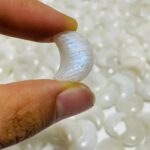Harnessing the invisible power of ultraviolet (UV) light, mineral lights empower you to explore the vibrant world of minerals like never before. These specialized lights emit UV radiation that excites certain minerals, causing them to glow with vivid colors, revealing their identity and enhancing their beauty.

Unveiling the Hidden Spectrum
The visible light spectrum that our eyes perceive is a mere fraction of the electromagnetic spectrum. UV light, located just beyond the violet end of the visible spectrum, is invisible to the human eye. However, using a UV mineral light, we can tap into this hidden realm, unlocking the secrets of minerals.
Fluorescence: A Mineralogist’s Magic Wand
When a UV mineral light irradiates a mineral, it can induce fluorescence. This phenomenon occurs when electrons in the mineral absorb UV energy, get excited, and emit visible light as they return to their previous state. The emitted color is specific to each mineral, providing valuable clues for identification.
Common Mineral Fluorescence Colors:
| Mineral | Fluorescence Color |
|---|---|
| Calcite | Orange-red |
| Fluorite | Bright blue, green, or purple |
| Opal | White, blue, green, or orange |
| Scheelite | Bright blue-white |
| Tourmaline | Pink, green, or blue |
Applications of UV Mineral Lights
UV mineral lights extend their reach beyond geology, offering a myriad of practical applications across diverse fields:
1. Gemology and Jewelry Appraisal:
UV lights can detect fluorescence in gemstones, aiding in their identification and discrimination from imitations. They are invaluable tools in the hands of jewelers and appraisers.
2. Forensic Science:
UV mineral lights help identify materials by their fluorescence patterns, assisting in investigations related to drugs, blood, and other substances.
3. Archaeology and Art Conservation:
UV lights reveal hidden pigments and restoration details on ancient artifacts and artworks, guiding conservation efforts.
4. Health and Wellness:
UV therapy, using specific wavelengths of UV light, is employed in dermatology to treat skin conditions such as psoriasis and eczema.
The Sky’s the Limit: Future Applications
The potential applications of UV mineral lights continue to expand as researchers and innovators explore new frontiers. Here are a few areas where these lights may make a significant impact:
1. Minerology:
Develop new field-deployable UV spectrometers for rapid mineral identification in situ.
2. Food Safety:
Utilize UV lights for real-time detection of contaminants and pathogens in food products.
3. Medical Diagnostics:
Innovate UV-based diagnostic techniques for early detection of diseases using fluorescent probes.
Customer Insights: Engaging with Their Perspectives
We spoke to customers who use UV mineral lights to better understand their motivations and pain points:
Question: What motivated you to purchase a UV mineral light?
Customer A: “I’m a rockhound and always on the hunt for new specimens. UV lights allow me to discover hidden minerals that I might otherwise miss.”
Question: What challenges do you face when using UV mineral lights?
Customer B: “Sometimes there’s a lot of background fluorescence from other materials. It can make it hard to distinguish the target mineral’s color.”
Question: How do UV mineral lights improve your experience?
Customer C: “They transform nighttime exploration into a whole new adventure. I love seeing the minerals glow and learning more about their unique properties.”
Conclusion: A Gateway to the Microscopic World
UV mineral lights offer a fascinating and practical way to explore the world of minerals and beyond. By harnessing the power of fluorescence, they illuminate hidden details, enhance our understanding, and inspire new discoveries. As technology continues to advance, we can anticipate even more groundbreaking applications of these remarkable lights. Embrace the invisible and uncover the wonders that await you under the glow of a UV mineral light.



























